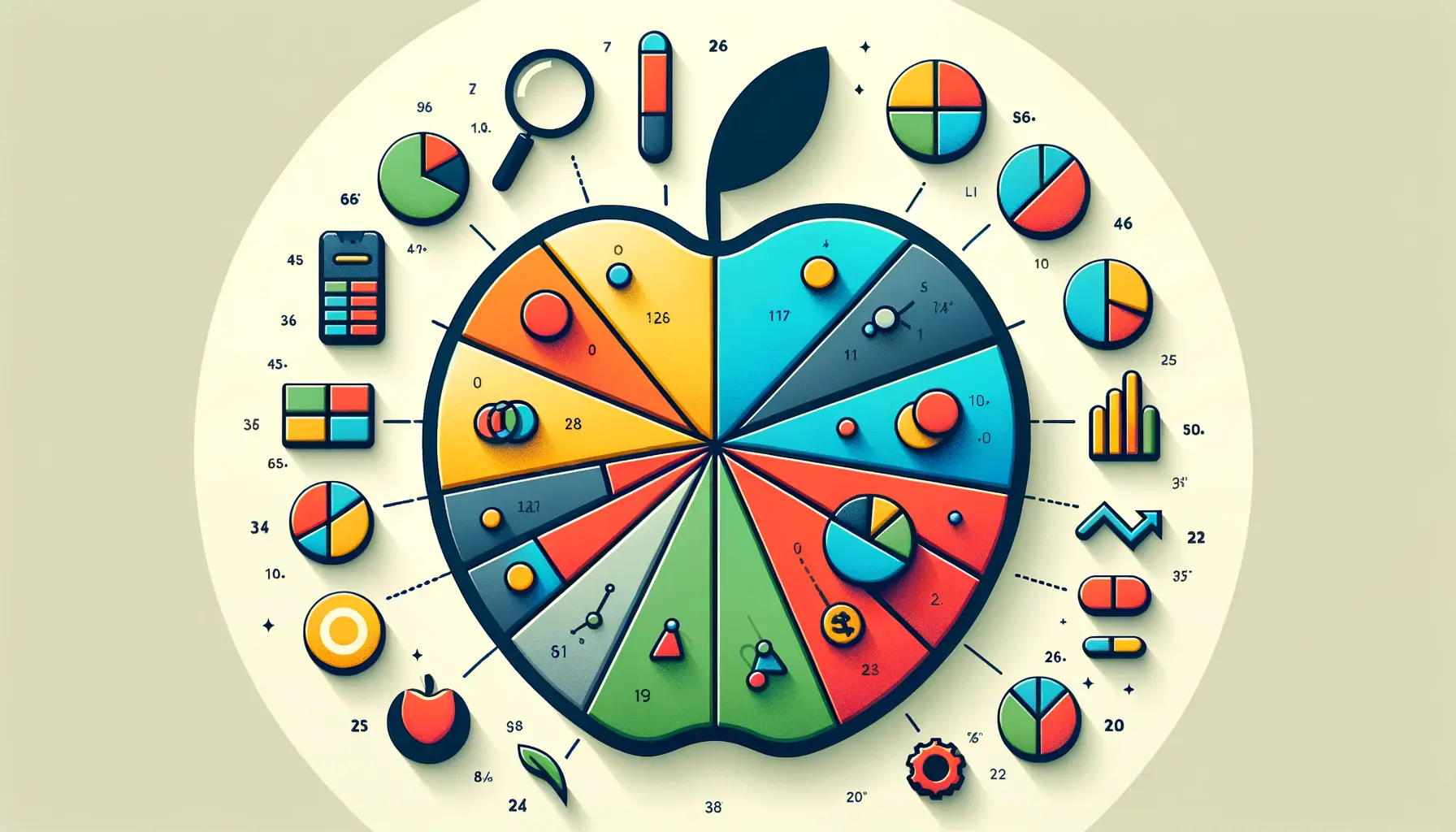In the rapidly evolving digital landscape, app attribution stands as a cornerstone for marketers aiming to understand and optimize their advertising efforts within the Apple ecosystem.
The introduction of Apple’s privacy-centric policies, particularly with the App Tracking Transparency (ATT) framework, has ushered in a new era of challenges and opportunities for app attribution.
This shift demands a reevaluation of strategies to ensure that businesses can effectively reach their target audiences while respecting user privacy.
As we delve into the future of app attribution with Apple, it’s crucial to recognize the balance between innovative advertising techniques and the increasing demand for user privacy.
This article aims to explore the intricate dynamics of app attribution in the context of Apple’s evolving policies, offering insights into how businesses can navigate this landscape to achieve their marketing objectives.
- Understanding App Attribution in Apple’s Ecosystem
- Strategies for Navigating App Attribution Post-ATT
- Adapting to Privacy-Centric User Expectations
- Utilizing Alternative Attribution Models
- Optimizing Campaigns for a Post-IDFA World
- Future Trends in App Attribution and Advertising
- Enhancing User Experience and Engagement
- Embracing the Future of App Attribution with Apple
- FAQs on The Future of App Attribution with Apple
Understanding App Attribution in Apple’s Ecosystem
App attribution within Apple’s ecosystem has historically relied on the Identifier for Advertisers (IDFA), allowing marketers to track user interactions and measure the effectiveness of their advertising campaigns.
However, the introduction of ATT in iOS 14.5 marked a significant shift, requiring apps to obtain explicit user consent before tracking their activities across other apps and websites.
This change has profound implications for app attribution, challenging marketers to adapt their strategies in a privacy-first environment.
The transition to a consent-based model underscores the importance of transparency and user trust in app marketing.
Marketers must now prioritize privacy-friendly attribution methods that comply with Apple’s guidelines while still providing valuable insights into user behavior.
This evolution presents an opportunity to explore alternative attribution frameworks, such as Apple’s SKAdNetwork, which offers a privacy-centric approach to measuring ad campaign performance without compromising user anonymity.
Impact of App Tracking Transparency on Marketers
The implementation of ATT has led to a significant decrease in access to user-level data, fundamentally altering how marketers approach app attribution.
With a substantial portion of users opting out of tracking, the granularity of data available for campaign optimization and audience targeting has diminished.
This shift necessitates a reevaluation of attribution models and the adoption of new metrics that can provide meaningful insights in the absence of IDFA-based tracking.
Despite these challenges, the changes introduced by Apple also encourage innovation in the realm of app attribution.
Marketers are now exploring new methodologies for measuring campaign effectiveness, such as incrementality testing and engagement metrics, that do not rely on traditional tracking mechanisms.
This adaptation not only aligns with privacy regulations but also paves the way for more sustainable and user-centric marketing practices.
The future of app attribution with Apple hinges on the industry’s ability to embrace privacy-centric approaches while maintaining the efficacy of advertising campaigns.
Strategies for Navigating App Attribution Post-ATT
As the digital advertising landscape continues to evolve in response to Apple’s privacy measures, marketers must adopt innovative strategies to navigate the complexities of app attribution effectively.
The key lies in leveraging available tools and methodologies that align with Apple’s privacy standards while ensuring the continued success of marketing campaigns.
Here, we explore several strategies that can help marketers adapt to the new norms of app attribution within the Apple ecosystem.
Embracing Apple’s SKAdNetwork
One of the most significant steps marketers can take is embracing Apple’s SKAdNetwork, designed to provide attribution data in a privacy-compliant manner.
This framework allows advertisers to measure the success of their campaigns without accessing user-level data, thereby respecting user privacy and complying with ATT regulations.
To make the most of SKAdNetwork, marketers should:
- Understand the conversion value mechanism to optimize campaign insights.
- Collaborate with ad networks and platforms that support SKAdNetwork integration.
- Regularly update their understanding and implementation strategies as Apple evolves the framework.
Optimizing for User Engagement and Retention
With the limitations on tracking imposed by ATT, focusing on user engagement and retention becomes even more crucial.
Marketers should shift their attention towards metrics that indicate user satisfaction and app value, such as session length, frequency of use, and in-app purchase behavior.
Strategies to enhance user engagement include:
- Creating personalized in-app experiences based on user behavior.
- Implementing loyalty programs to encourage repeat usage and transactions.
- Utilizing push notifications and in-app messages to increase engagement.
Leveraging First-Party Data
The importance of first-party data has never been more pronounced.
With direct access to user interactions within their own apps, marketers can gather insights into user preferences and behaviors without infringing on privacy.
Effective use of first-party data involves:
- Developing a robust data collection framework within the app.
- Ensuring transparency and obtaining user consent for data collection.
- Utilizing data analytics tools to derive actionable insights from collected data.
Innovative approaches to app attribution in the post-ATT era require a balance between respecting user privacy and achieving marketing objectives. By adopting privacy-centric attribution models, focusing on user engagement, and leveraging first-party data, marketers can navigate the challenges posed by Apple’s privacy measures.
Adapting to Privacy-Centric User Expectations
The shift towards a more privacy-focused digital environment, spearheaded by Apple’s ATT, has not only transformed app attribution practices but also significantly altered user expectations regarding privacy.
Users are now more aware of their data rights and demand greater control over how their information is used.
Adapting to these expectations is crucial for marketers aiming to build trust and foster long-term relationships with their audience.
Enhancing Transparency and Building Trust
To meet the evolving expectations of users, marketers must prioritize transparency in their data collection and usage practices.
This involves clearly communicating the purpose of data collection and how it benefits the user, thereby fostering a trust-based relationship.
Strategies for enhancing transparency include:
- Implementing clear and concise privacy policies that are easily accessible to users.
- Providing users with straightforward options to manage their privacy preferences.
- Engaging in open and honest communication about data security measures.
Privacy as a Competitive Advantage
In a landscape where privacy concerns are paramount, leveraging privacy as a competitive advantage can set brands apart.
By emphasizing their commitment to protecting user data and respecting privacy, companies can attract privacy-conscious consumers.
Key approaches include:
- Highlighting privacy-friendly features in marketing communications.
- Developing and promoting products or services that prioritize user privacy.
- Adopting privacy certifications and seals to demonstrate compliance with high privacy standards.
Investing in Privacy Technology and Compliance
Staying ahead in the privacy-centric market requires continuous investment in technology and processes that ensure compliance with privacy regulations.
This not only helps in adhering to legal requirements but also signals to users that their privacy is taken seriously.
Essential investments include:
- Advanced data encryption and security technologies to protect user data.
- Regular audits and assessments to ensure compliance with privacy laws and standards.
- Training and development programs for staff on privacy best practices and ethical data handling.
Adapting to privacy-centric user expectations is not just about compliance; it’s about embracing privacy as a core value that guides all marketing efforts. By doing so, marketers can build stronger, trust-based relationships with their audience, ultimately leading to higher engagement and loyalty.
Utilizing Alternative Attribution Models
In response to the limitations imposed by Apple’s privacy measures, marketers are compelled to explore alternative attribution models that align with the new privacy landscape.
These models must provide valuable insights into campaign performance without relying on granular user data.
By diversifying their approach to attribution, marketers can continue to measure and optimize their campaigns effectively in a privacy-conscious environment.
Incrementality Testing
Incrementality testing emerges as a powerful strategy for understanding the true impact of advertising efforts by measuring the lift that advertising spend contributes to the overall business outcomes.
This approach helps marketers identify which campaigns are genuinely driving value, enabling more efficient allocation of advertising budgets.
Key steps in implementing incrementality testing include:
- Designing controlled experiments to compare the behavior of exposed groups to control groups.
- Analyzing the difference in outcomes to determine the incremental impact of the campaign.
- Adjusting campaign strategies based on insights gained from incrementality tests.
Media Mix Modeling (MMM)
Media Mix Modeling (MMM) offers a macro-level view of marketing performance by analyzing historical data to understand the effectiveness of various media investments across channels.
MMM takes into account external factors such as economic conditions, seasonality, and competitive actions, providing a comprehensive view of marketing effectiveness.
To leverage MMM, marketers should:
- Collect and integrate data from across all marketing and sales channels.
- Apply statistical analysis to identify correlations between marketing spend and business outcomes.
- Use insights from MMM to inform strategic decisions about budget allocation and channel optimization.
Engagement-Based Attribution
With the shift towards privacy, engagement-based attribution models gain prominence by focusing on user interactions within the app as indicators of campaign success.
This model attributes value to campaigns that drive meaningful engagement, such as time spent in the app, level of interaction, and completion of key in-app actions.
Implementing an engagement-based model involves:
- Defining key engagement metrics that align with business objectives.
- Tracking in-app user behavior to assess the impact of different campaigns.
- Optimizing campaigns to maximize user engagement and achieve desired outcomes.
Exploring alternative attribution models is essential for marketers navigating the post-ATT landscape. By adopting methods such as incrementality testing, media mix modeling, and engagement-based attribution, marketers can gain insights into campaign performance while upholding user privacy.
Optimizing Campaigns for a Post-IDFA World
With the introduction of Apple’s App Tracking Transparency (ATT) framework significantly altering the landscape of digital advertising, marketers are tasked with finding new ways to optimize their campaigns in a post-IDFA world.
This shift requires a strategic reevaluation of campaign design, targeting, and measurement to ensure effectiveness while adhering to privacy regulations.
Contextual Advertising
As a response to the limitations on user-specific targeting, contextual advertising has resurfaced as a potent strategy.
This approach involves placing ads based on the content of the website or app, rather than on user behavior, ensuring relevance without compromising privacy.
To effectively implement contextual advertising, marketers should:
- Analyze the environment where ads are placed to ensure alignment with the target audience’s interests.
- Utilize advanced algorithms and natural language processing to match ads with relevant content accurately.
- Monitor campaign performance to refine contextual targeting strategies continuously.
Creative Optimization
In a landscape where granular targeting options are constrained, the creative elements of an ad campaign play a crucial role in engaging the audience.
Creative optimization involves continuously testing and refining ad creatives to resonate with the target audience effectively.
Strategies for creative optimization include:
- Implementing A/B testing to compare different creative variations and identify the most effective ones.
- Leveraging user feedback and engagement metrics to guide creative development.
- Adapting creatives based on contextual insights to enhance relevance and engagement.
Performance Benchmarking
Without access to detailed user-level data, establishing clear performance benchmarks becomes essential for measuring campaign success.
Performance benchmarking allows marketers to set realistic goals based on industry standards and historical data.
Key considerations for effective benchmarking include:
- Identifying relevant metrics that accurately reflect campaign objectives and success.
- Gathering industry-specific benchmark data to set achievable targets.
- Regularly reviewing and adjusting benchmarks to reflect changing market conditions and campaign performance.
Optimizing campaigns in a post-IDFA world requires a shift towards privacy-friendly strategies such as contextual advertising, creative optimization, and performance benchmarking. By focusing on these areas, marketers can navigate the challenges of reduced access to user data while still delivering impactful advertising campaigns.
Future Trends in App Attribution and Advertising
The landscape of app attribution and advertising within Apple’s ecosystem is poised for continuous evolution.
As privacy regulations become more stringent and user expectations shift towards greater data control, marketers and developers must stay ahead of the curve.
This section explores emerging trends that are likely to shape the future of app attribution and advertising, offering a glimpse into what lies ahead.
Advancements in Machine Learning and AI
Machine learning and artificial intelligence (AI) are set to play a pivotal role in the future of app attribution.
These technologies offer the potential to analyze vast amounts of data to identify patterns and insights without relying on personal identifiers.
Marketers can expect:
- Improved predictive modeling capabilities to forecast user behavior and campaign performance.
- Enhanced segmentation and targeting based on behavioral and contextual data.
- Automated optimization of ad campaigns for efficiency and effectiveness.
Increased Focus on Privacy-Enhancing Technologies
As the digital advertising industry grapples with privacy challenges, privacy-enhancing technologies (PETs) will become increasingly important.
PETs enable the processing of personal data in a way that maximizes user privacy.
Future developments may include:
- Adoption of differential privacy techniques to aggregate data while preserving individual anonymity.
- Implementation of secure multi-party computation to analyze data across different parties without sharing the underlying data.
- Development of federated learning systems for decentralized data processing and analysis.
Growth of First-Party Data Ecosystems
The importance of first-party data is expected to rise significantly in the face of privacy restrictions.
Brands and app developers will invest more in building their first-party data ecosystems to gather insights directly from their user base.
This trend will likely lead to:
- Enhanced customer relationship management (CRM) systems to better manage and analyze first-party data.
- Increased use of in-app surveys and feedback mechanisms to gather user insights.
- Greater emphasis on loyalty programs and direct engagement strategies to encourage data sharing.
The future of app attribution and advertising in Apple’s ecosystem will be characterized by a delicate balance between leveraging advanced technologies and upholding user privacy. By embracing machine learning, privacy-enhancing technologies, and first-party data, marketers can navigate the evolving landscape effectively.
Enhancing User Experience and Engagement
In the evolving landscape of app attribution within Apple’s ecosystem, enhancing user experience and engagement emerges as a critical strategy for marketers.
As privacy regulations tighten and the effectiveness of traditional ad targeting diminishes, providing a superior user experience becomes paramount.
This approach not only aligns with privacy-centric advertising but also fosters loyalty and improves retention rates, driving long-term success.
Personalization Without Compromising Privacy
Personalization has long been a cornerstone of effective marketing, but in a privacy-first world, achieving it without infringing on user privacy is a challenge.
Marketers must explore innovative ways to personalize the user experience while respecting privacy boundaries.
Strategies include:
- Leveraging machine learning algorithms to deliver personalized content based on in-app behavior rather than personal data.
- Utilizing contextual signals to tailor experiences without relying on cross-app tracking.
- Encouraging users to set preferences within the app to guide personalized experiences.
Improving In-App User Journeys
The user journey within an app plays a significant role in engagement and retention.
Optimizing this journey based on user feedback and behavior can significantly enhance the overall experience.
Key areas of focus should include:
- Simplifying navigation and streamlining the onboarding process to reduce friction.
- Implementing feedback loops to gather user insights and identify areas for improvement.
- Regularly updating app content and features to keep the experience fresh and engaging.
Utilizing Gamification Techniques
Gamification is an effective tool for increasing engagement by incorporating game-like elements into non-game contexts.
By applying gamification techniques, marketers can make the app experience more interactive and rewarding.
Effective gamification strategies involve:
- Incorporating challenges and rewards to motivate desired behaviors within the app.
- Using progress tracking and achievement badges to encourage continued engagement.
- Creating competitive or social elements to foster a sense of community among users.
Enhancing user experience and engagement is essential for navigating the future of app attribution in a privacy-centric advertising landscape. By focusing on personalization, optimizing user journeys, and employing gamification, marketers can drive engagement and build lasting relationships with their audience.
Embracing the Future of App Attribution with Apple
The journey through the evolving landscape of app attribution in the Apple ecosystem reveals a future where privacy and user experience stand at the forefront.
As Apple continues to implement stringent privacy measures, marketers are tasked with navigating these changes creatively and ethically.
The future of app attribution with Apple is not just about adapting to new rules but about reimagining how we engage with users in meaningful and respectful ways.
Strategic Adaptations for Marketers
Marketers must embrace a multifaceted approach to thrive in this new environment.
This includes leveraging Apple’s SKAdNetwork for privacy-compliant attribution, optimizing campaigns for engagement rather than mere exposure, and utilizing alternative attribution models like incrementality testing and media mix modeling.
Moreover, the emphasis on first-party data and privacy-enhancing technologies will be crucial for developing deeper, trust-based relationships with users.
Creating Value in a Privacy-First World
The shift towards a privacy-first advertising world demands innovation and a focus on delivering value to users.
Personalization strategies that respect user privacy, enhancing in-app user journeys, and employing gamification techniques are pivotal.
These strategies not only align with Apple’s privacy standards but also cater to the evolving expectations of users, ensuring a seamless and engaging user experience.
- Advancements in AI and machine learning will continue to offer new ways to understand and predict user behavior without compromising privacy.
- The adoption of privacy-enhancing technologies will become more widespread, offering marketers tools to balance effective advertising with user privacy.
- Investment in first-party data ecosystems will grow, enabling brands to gather insights directly from their user base in a compliant manner.
In conclusion, the future of app attribution with Apple is poised for significant transformation, driven by the dual forces of technological innovation and a deepening commitment to user privacy.
Marketers who navigate this landscape with agility, respect for user privacy, and a focus on delivering genuine value will not only survive but thrive.
The path forward is clear: embrace change, prioritize privacy, and engage users with meaningful experiences that resonate on a personal level.
If you're seeking expertise in Apple Search Ads campaigns, visit our service page for professional management!
FAQs on The Future of App Attribution with Apple
Explore commonly asked questions to gain deeper insights into the evolving world of app attribution with Apple.
SKAdNetwork is Apple’s framework for attributing app installs in a privacy-friendly way, providing advertisers with conversion data without compromising user privacy.
ATT requires apps to obtain user consent before tracking their activities, significantly impacting how marketers collect and use data for targeting and attribution.
Yes, but with limitations. Marketers must rely on aggregated data, first-party data, and contextual targeting to personalize ads without infringing on privacy.
Methods include using Apple’s SKAdNetwork, applying machine learning for predictive analytics, and leveraging first-party data for insights without tracking users across apps.
Marketers can optimize campaigns by focusing on contextual advertising, creative testing, and engagement metrics to measure and enhance campaign performance.
Machine learning will be crucial for analyzing behavioral patterns and optimizing campaigns without relying on personal identifiers, enhancing privacy-compliant attribution.
First-party data is increasingly vital for understanding user behavior and personalizing experiences within privacy guidelines, making it a cornerstone of future app attribution strategies.
Marketers should prepare for advancements in AI, increased use of privacy-enhancing technologies, and a greater focus on first-party data to navigate the future of app attribution.












